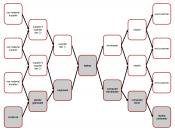THE BURNING ISSUE Customer satisfaction has been in reverse for seemingly and interminable time. Driven by an aphasic view to Information Technology (IT) and pontifical Corporate Culture, the inheritance of the current board is to deal with ramifications of previous decisions. Loss of market share has forced GM to realise that extreme changes must be implementedTHE OVERVIEW The precipice that GM has found itself looking at is the result of evolutions in IT and a corporate culture that would be described as haughty in its mannerism. MooreÃÂs Law observes that computers will double in capacity every 2 years. The systems operating in GM were incapable of evolving along with the hardware and applications that were being uses. These systems lead to the decline in customer satisfaction. These legacy systems also had a flow on effect in that there was data duplication. By changing data in department or process, all other aspects of the organisation would need to be notified, to update their systems.
An imperious attitude of, weÃÂll make it, and youÃÂll take it, has contributed to GMÃÂs decline in market share. While focusing on the end user, GM did not dedicate enough energy on their other stakeholders, and the value of their supply chain.
THE IDEA MADE TANGIBLE, ÃÂITÃÂFor GM to countermand their situation the coupling of developing a Web based IT system, further evolution of 4th Party Logistics, concentrating on their Core Competencies, adhering to a Lean philosophy and Co-operating and communicating with their stakeholders. The necessity for the GM, as for the BIG 3, to develop a web based IT system, as they have all grown through acquisition. The resulting effect is a potpourri software and hardware that is not interchangeable, with a web IT approach, all members of the supply chain will enable GM and their stakeholders to reduce costs and meet and exceed their gaols. Recognising that they donÃÂt have the expertise in providing suitable logistics services, GM has contracted a 4th Party provider, to over see their current services and make improvements. Their joint venture with Vector SCM has already started to pay dividends with a 20% reduction in costs over a five-year period. To elevate their position as market leader, in sales and development, it is recommended that GM revert to a core competency Manufacturing and Research and Development. The result, in collusion with other changes to the organisation, will be a more refined product that will be actively sought by consumers and reproduced by their competitors. While Ford is haemorrhaging funds and Chrysler is still attempting to merge its two cultures, GM is encouraged to disentangle itself from its legacy process, and to develop a viable Lean/JIT system that is capable of growth. This new system will ensure that GM able to control cost in a changing market place, and able to make the most of a first mover advantage. By changing the methods in which they communicate and co-operate with all members in their supply chain, and other stakeholders GM must continually evolve their communication process, and openly seek the opinions of their stakeholders.
THE PAYOFFRepercussions from the changes should result in three principle categories of improvement; Decreased Lead Time, Decreased Supply Chain all resulting in Increased Margins. The lead time to the consumer will result in increased sales and increased customer satisfaction and GM should be confident of radically decreasing the special-order vehicles from their extreme delivery time of 80 days. Likewise GM has shown an increase to 90% of their deliveries arriving on time. The imperical data has proven to be unreliable, as at many ÃÂgatewaysÃÂ information was not collected. A Tabula Rosa for GM will be a position from which to judge all changes. Following on from the changes that have been suggested and made, GM will have the tools and resources to reverse the trend of losses and growth. A decrease of 20% has been mentioned by GM, in relation to their Supply Chain costs, additionally they have made savings of 30% in their employment costs. A $1 Billion reduction in their IT supply chain costs has had a flow on effect in that GM has been able to track the location and condition of their vehicles; this has also reduced costs in transit damage, by streamlining their delivery routes. The ability to increase returns to stakeholders has to be at the core of any change to GM as they have been able to increase their margins throughout their rage of products.
THE INTERACTIVE CLOSEBy imbuing suggestions sought and made, GM can once again have its market share. By changing their Corporate Culture, being Proactive and finding ways to eliminate waste, GM can increase their customer satisfaction and retention. The opportunities that are present to GM can supply them with a strategic advantage for generations to come.
Cohen, S and Roussel, J., 2004, Strategic Supply Chain Management, McGraw ÃÂ Hill, Sydney, Australia.
General Motors, accessed 17/08/2008, http://www.gm.com/Intel, MooreÃÂs Law, accessed 17/08/2008, http://download.intel.com/museum/Moores_Law/Printed_Materials/Moores_Law_2pg.pdfForbes.com, Pumping on the Brakes, accessed 17/08/2008, http://www.forbes.com/columnists/2007/01/01/gm-market-share-oped-cz_jf_0102flint.htmlCBC News, The not-so-big-Three, accessed 17/08/2008, http://www.cbc.ca/news/background/autos/bigthree.htmlDictionary.com, accessed 17/08/2008, http://dictionary.reference.com/Thesaurus.com, accessed 17/08/2008, http://thesaurus.reference.com/Styger, L., 2008, TBS 950 Quality Management, Lecture 1 Notes, Graduate School of Business, University of WollongongHoff, R., 1996, Say it in Six, Andrews and McMeel, Kansas City, USA





